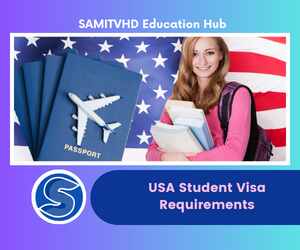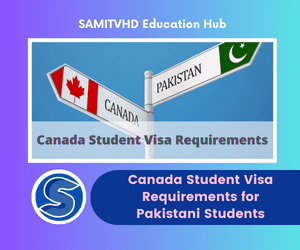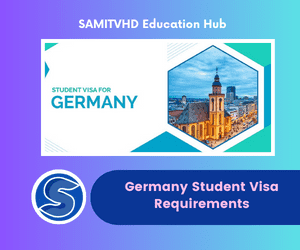
USA Student Visa Requirements A to Z Setup
USA Student Visa Requirements A to Z Setup
Studying in the United States is a dream for many international students, offering access to world-class education and diverse cultural experiences. However, before embarking on this journey, it’s crucial to understand the USA student visa requirements and procedures. From application to post-graduation options, this comprehensive guide will walk you through everything you need to know about obtaining a student visa for the USA.
1. Introduction to USA Student Visa
What is a student visa?
A student visa is a legal document issued by the US government that allows foreign nationals to study at accredited educational institutions in the United States.
Importance of obtaining a student visa for studying in the USA
Obtaining a student visa is essential for international students as it grants legal permission to study in the USA and ensures compliance with immigration laws.
2. Types of USA Student Visas
There are primarily three types of student visas for the USA:
F-1 Visa
The F-1 visa is the most common type for academic studies in the USA, including language training programs.
J-1 Visa
The J-1 visa is for exchange visitors participating in approved programs for the purpose of teaching, studying, conducting research, or receiving training.
M-1 Visa
The M-1 visa is for students enrolled in vocational or non-academic programs.
3. Eligibility Criteria for USA Student Visas
To qualify for a student visa in the USA, applicants must meet certain eligibility criteria, including:
Academic acceptance
Applicants must have been accepted by a US school or program certified by the Student and Exchange Visitor Program (SEVP).
Financial requirements
Applicants must demonstrate sufficient funds to cover tuition fees, living expenses, and other educational costs.
Intent to return to home country
Applicants must prove their intent to return to their home country upon completion of their studies.
4. Application Process for USA Student Visas
The application process for a USA student visa involves several steps:
Form DS-160
Applicants must complete the online nonimmigrant visa application form (DS-160) and upload a recent photograph.
Payment of SEVIS fee
Applicants must pay the SEVIS (Student and Exchange Visitor Information System) fee and receive a payment confirmation.
Visa interview
Applicants must schedule and attend a visa interview at the US embassy or consulate in their home country.
5. Documents Required for USA Student Visa Application
Applicants must gather and submit various documents to support their visa application, including:
Passport
A valid passport with a validity date at least six months beyond the intended period of stay in the USA.
Form I-20 (for F-1 and M-1 visas)
The Form I-20 is a Certificate of Eligibility issued by the educational institution and is required for F-1 and M-1 visa applicants.
DS-160 confirmation page
A printed confirmation page of the DS-160 application form.
Financial documents
Evidence of financial ability to cover tuition, living expenses, and other costs.
Academic transcripts and certificates
Official transcripts and academic certificates from previous educational institutions.
6. SEVIS and Visa Interview
Importance of SEVIS in the visa process
SEVIS is an integral part of the student visa process as it maintains information on international students and their dependents.
Preparing for the visa interview
Applicants should prepare thoroughly for the visa interview by reviewing their application, understanding the purpose of their visit, and practicing potential interview questions.
7. Visa Interview Tips
Dress code and appearance
Applicants should dress professionally and avoid casual attire during the visa interview.
Confidence and communication skills
Confidence and clear communication are essential during the visa interview to convey genuine intentions and qualifications.
Knowledge about the chosen course and university
Applicants should be knowledgeable about their chosen course of study and the educational institution they plan to attend.
8. Visa Approval and Denial
Factors Affecting Visa Approval
Visa approval depends on various factors, including the applicant’s eligibility, documentation, and interview performance.
Common reasons for visa denial
Visa denials may occur due to insufficient documentation, lack of financial resources, or concerns about the applicant’s intent to return home.
9. USA Student Visa Processing Time
Understanding the processing timeline
The processing time for a student visa varies depending on the applicant’s home country and the time of year.
Expedited processing options
Some applicants may qualify for expedited processing under certain circumstances, such as medical emergencies or urgent academic deadlines.
10. Maintaining Status on USA Student Visa
Full-time enrollment
Students must maintain full-time enrollment and make satisfactory academic progress to remain in compliance with their visa status.
Reporting changes to SEVIS
Students must report any changes in their program, address, or academic status to the designated school official (DSO) and update their SEVIS record accordingly.
On-campus employment regulations
International students are typically allowed to work part-time on campus during the academic year and full-time during scheduled breaks.
11. Visa Renewal and Extension
Extending the duration of stay
Students may apply for a visa renewal or extension if they need additional time to complete their studies.
Reapplying for a visa after expiration
Students who have allowed their visa to expire must follow the reapplication process and meet all eligibility requirements.
12. Working on a USA Student Visa
On-campus employment
Students on an F-1 visa are eligible for on-campus employment opportunities without additional authorization.
Off-campus employment options
Off-campus employment options for international students include Curricular Practical Training (CPT) and Optional Practical Training (OPT).
13. Post-Graduation Options
Optional Practical Training (OPT)
OPT allows students to gain practical work experience in their field of study for up to 12 months after completing their academic program.
H-1B visa sponsorship
Students may pursue H-1B visa sponsorship from a US employer to continue working in the USA after OPT.
14. Health Insurance Requirements
Mandatory health insurance for international students
Most US universities require international students to have health insurance coverage to access medical services during their stay.
Coverage options and providers
Students can choose from various health insurance plans offered by their educational institution or purchase private insurance coverage.
15. Conclusion
Studying in the USA offers incredible opportunities for academic and personal growth. By understanding the student visa requirements and procedures outlined in this guide, you can navigate the process with confidence and embark on a rewarding educational journey in the United States.
FAQs (Frequently Asked Questions)
1. Can I work while studying in the USA on a student visa?
Yes, international students on an F-1 visa are typically allowed to work part-time on campus during the academic year and full-time during scheduled breaks.
2. How long does it take to process a student visa for the USA?
The processing time for a student visa varies depending on the applicant’s home country and the time of year. It is advisable to apply well in advance of the intended start date.
3. What happens if my USA student visa is denied?
If your student visa is denied, you will receive a written explanation from the consular officer outlining the reasons for denial. You may have the option to reapply after addressing any deficiencies in your application.
4. Can I extend my stay in the USA on a student visa?
Yes, students may apply for a visa renewal or extension if they need additional time to complete their studies. However, approval is not guaranteed and is subject to meeting eligibility criteria.
5. What are my options for working in the USA after completing my studies?
After completing your studies, you may be eligible for Optional Practical Training (OPT) to gain work experience in your field of study. You can also explore H-1B visa sponsorship from a US employer to continue working in the USA.



